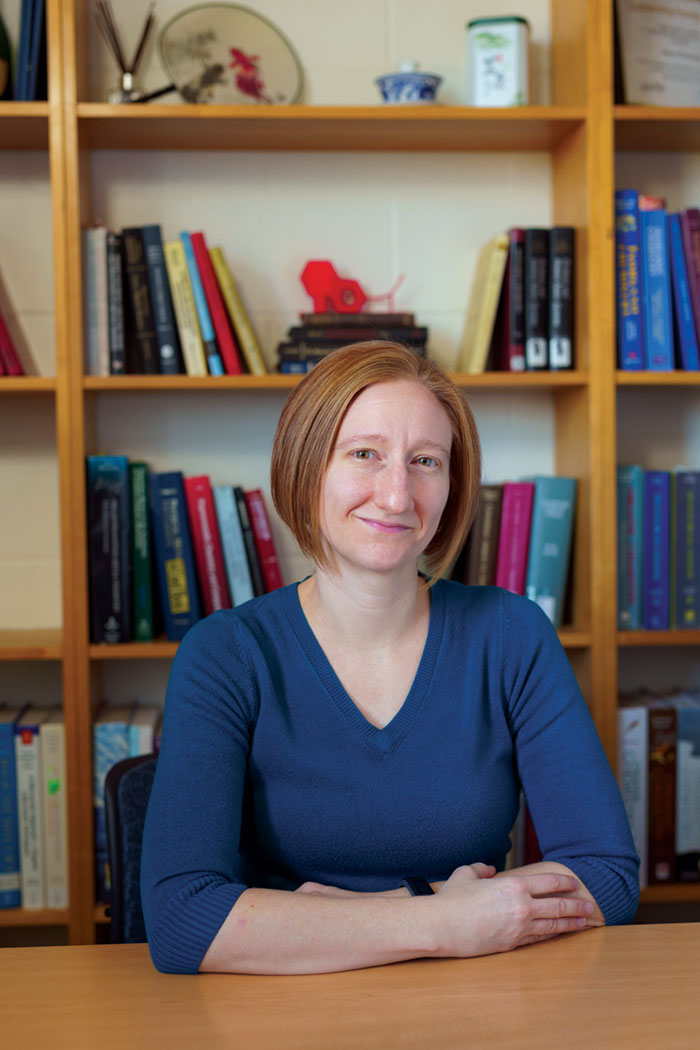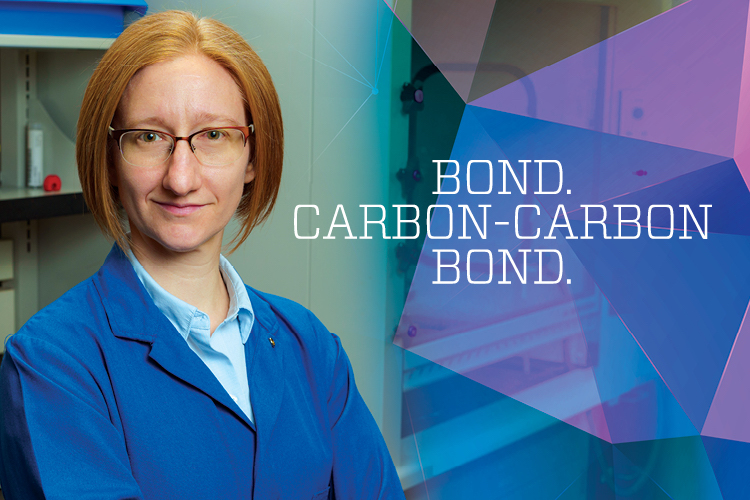Bond. Carbon-Carbon Bond.
When not investigating new catalytic reactions, Jessica Hoover ’04 is introducing the public to the beauty, mystery and intrigue of chemistry.
When Jessica Hoover ’04 entered Harvey Mudd College, she planned to major in engineering. “Then I took my first engineering course, and that was the end of that,” she recalls with a chuckle. Next, Hoover tried math, which didn’t feel right either. When she started doing research with chemistry Professor Adam Johnson, however, everything changed. “Chemistry clicked for me,” she says simply. “And Professor Johnson was an incredible mentor, then and now. If I hadn’t done research as an undergrad, I honestly don’t know what I’d be doing today.”
Fortunately, Hoover’s career path is no longer in question. Now an associate professor of chemistry at West Virginia University, she is focused on developing and understanding new catalytic reactions and is garnering a great deal of attention for her efforts. In fact, Hoover’s recent work on a complex class of reactions called decarboxylative cross-couplings shows great promise for improving the efficiency of new medicine creation.

“Our research is fundamental, not applied,” Hoover explains. “We’re not making medicine— we’re making new ways to make some of the molecules that are used in pharmaceuticals.”
Coupling reactions in general are an important way to make carbon-carbon bonds (2010 Chemistry Nobel Prize), but they often use organometallic coupling partners that are very reactive, making these starting materials hard to store and transport and requiring special equipment to handle. Using these reagents as coupling partners often means more synthetic steps to make the coupling partners and then to remove the byproducts that form as a result.
“Carboxylic acids are very inexpensive and stable compounds, making them great to work with, but not very reactive coupling partners,” says Hoover. “We can coax reactivity from them using a metal catalyst to form the reactive organometallic intermediate during the reaction from the decarboxylation (loss of CO2) of a carboxylic acid. This is the decarboxylative coupling reaction that we are studying and, in the ideal case, these reactions form small amounts of CO2 as the only byproduct.”
Should their work prove fruitful, says Hoover, it will provide chemists with reactions that are more efficient and less wasteful. It might also provide access to new molecules.
Hoover’s research group plans to use benzoic acids as a replacement for current coupling materials. “They’re bench stable—we don’t need any special equipment to handle them—they’re less expensive, and they offer us a way to access the same targets.”
Hoover has received two, multi-year National Institutes of Health grants to study heteroarenes, substructures found in many of the biologically active molecules common in pharmaceuticals. “Chemists’ understanding and predictivity for the behaviors of heteroarenes are not very advanced,” she notes, “so our goal is to use one of our reactions as a benchmark to see if we can shed some light on their coupling reactions.”
“If our methods can be applied to a variety of carboxylic acids, it will not only make it easier and less expensive for chemists to formulate new medicines, but also to make new compounds such as polymers and plastics,” says Hoover. “Anytime we’re connecting to heteroarenes, we could realize gains in efficiency and cost.”
My idea was to put beautiful sculptures, inspired by chemistry, right in people’s paths.
– Jessica Hoover ’04
Bonding with the Public
When Hoover isn’t concentrating on making molecules more accessible to fellow chemists, she turns her attention to making chemistry more accessible to the general public through CESTA (Community Engagement in Science Through Art), a program she funded through the outreach component of her 2015 NSF CAREER award.
For one month each of the past four summers, Hoover has joined forces with WVU sculpture Professor Jason Lee and engineering Professor Todd Hamrick to lead a team of six undergraduates and graduates in creating science-art installations that engage the local community in chemistry. “I started thinking about the public’s resistance to chemistry—big pharma and big oil are oftentimes viewed as villains—and I realized that resistance was emotional,” Hoover explains. “So, I decided to see if we could target that emotional component to introduce people to the beauty and mystery and intrigue of chemistry instead.”

Museum exhibitions and internet videos offer excellent opportunities to explore the wonders of chemistry, Hoover says, but they require people to seek them out. “My idea was to put beautiful sculptures, inspired by chemistry, right in people’s paths.”
The idea proved more challenging to implement than Hoover envisioned. “Placing works outside in public places involves a lot of red tape,” she says. “In the end, we weren’t able to display the first year’s sculpture as planned.” Hoover subsequently worked a deal with the university’s library system, which permitted students to install their creations within the libraries’ public spaces.
Apart from that initial hiccup, the project succeeded beyond Hoover’s expectations. “The participating students have been absolutely incredible,” she says. “The chemistry art pieces they’ve designed and built have been so creative. They were all big pieces, and each was interactive in some way.”
This year’s installation, The Brain Complex, is no exception. “It’s a four-part sculpture, a piece for each lobe of the brain,” Hoover explains. “Each piece has a peep hole and when viewers look inside, they see a nod to the chemical processes that happen in that section of the brain. It’s fascinating and very well done.”
Hoover welcomes the chance to mentor students in this way and makes a concerted effort to guide undergraduates in her lab as well. “Through my research group, I’ve worked with 27 undergraduates in seven years,” she says, smiling. “Professor Johnson had such an impact on me as an undergraduate at Harvey Mudd that I really enjoy the opportunity to pay it forward.”

